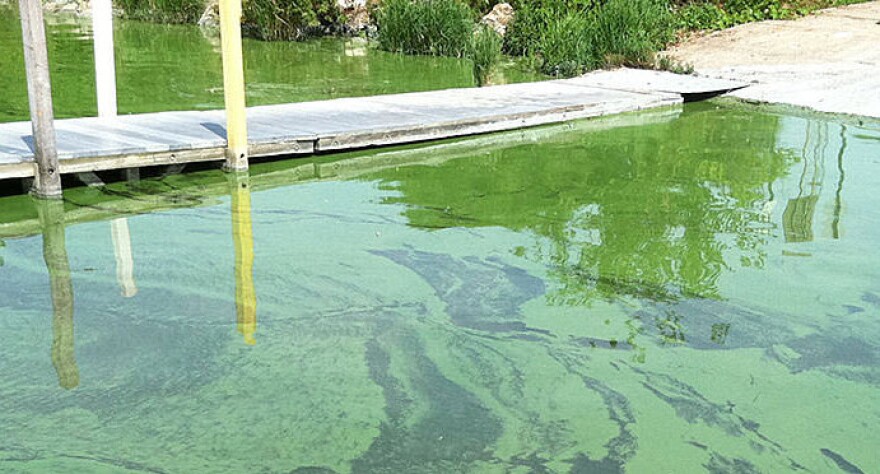Toledo voters will go to the polls on Tuesday to decide the fate of the Lake Erie Bill of Rights referendum.
The referendum would amend Toledo's city charter to give the lake rights, including the right to exist and flourish, and allow any Toledo resident to legally advocate on its behalf.
The campaign began about a year after Toledo's drinking water supply was shut down for three days in August, 2014 - when a bright green mass of cyanobacteria surrounded the water intake in western Lake Erie. The cyanobacteria produces a toxin called microcystin, which got into the water supply.
More than 400,000 people were told to stop drinking their tap water until the mass moved away. Since then, the blooms have persisted in the summer, fed mainly by manure and fertilizer runoff from nearby farms.
(You can learn more about that 2014 incident here.)
Sue Carter supports the Lake Erie Bill of Rights. Her property abuts the western shore of the lake, where the blooms appear every summer.
"It's full of foam, green slime....it looks and smells terrible....dead carp that are gasping for air - and it happens all the time," says Carter.
Experts say the amendment, if adopted, is unlikely to hold up in court. Many so-called community rights measures have been adopted by voters in other states, only to be struck down as unconstitutional for attempting to abrogate powers belonging to states or the federal government.
But it's a sign of just how desperate people in Toledo are to clean up the green slime that threatens their drinking water, not to mention swimming, fishing, or boating.
Carter and other supporters held a press conference last week to criticize radio ads blanketing the region urging a "no" vote. The ads, mounted by a PAC called the Toledo Jobs and Growth Coalition, warn of dire consequences should the referendum pass, including driving small farmers out of business, and raising food prices.
Yvonne Lesicko is with the Ohio Farm Bureau. She says the Bureau is not associated with the group mounting the ads, but does share the concerns of local farmers, especially the fear of widespread nuisance lawsuits.
"That means every farmer who is in the Lake Erie watershed, so that's the 35 counties in Northern Ohio, are at risk of a lawsuit being brought against them," she says.
Lesicko says farmers are concerned about Lake Erie, and are taking steps to try to keep phosphorus out of it. Cyanobacteria thrives on phosphorus-containing fertilizers, as well as phosphorus-rich manure produced by large-scale concentrated animal feeding operations (CAFOs).
But the problem is, most of these efforts are voluntary -- and they're clearly not working. Researchers say dissolved phosphorus flowing into the lake has risen 130% in the past few years.
Tish O'Dell is with the Community Environmental Legal Defense Fund, which helped Toledo residents craft the charter amendment. She says people are sick and tired of hearing messages like this from the agricultural community and state environmental regulators:
"Well, if the people would just wait another 15 to 20 years for our [efforts to] reduce fertilizer, maybe we'd see an impact. I'm like, the lake will be dead in 20 years," she says.
O'Dell concedes that if it passes, the Toledo measure could be struck down by the courts. But she points out that civil rights movements have changed the law many times in the U.S.
O'Dell thinks the courts will eventually recognize that the environment has rights, just as they've recognized corporations have rights.
Meanwhile, mainstream environmental groups are staying out of this fight, though they share the frustration.
Howard Learner is with the Environmental Law and Policy Center. In his view, a new legal approach isn't necessary. He says the U.S. EPA could and should fully enforce the Clean Water Act, focusing on the worst polluters - the large-scale corn, soy and animal feed lot operations - not the small farmers.
"In the best of worlds, U.S. EPA would step up and say to the Ohio EPA 'you have to act now to aggressively reduce the amount of manure and other phosphorus runoff going into western Lake Erie," says Learner.
But so far that hasn't happened. Learner's group filed a lawsuit in federal court earlier this month seeking an order that would establish what's called a TMDL (total maximum daily load) for phosphorus.
The TMDL would require Ohio to figure out more precisely where the pollution is coming from, and devise a holistic strategy to keep the amount of phosphorus flowing into Lake Erie under the TMDL.
Learner says that would offer the best hope for making parts of western Lake Erie blue again in the summer, instead of bright green.








